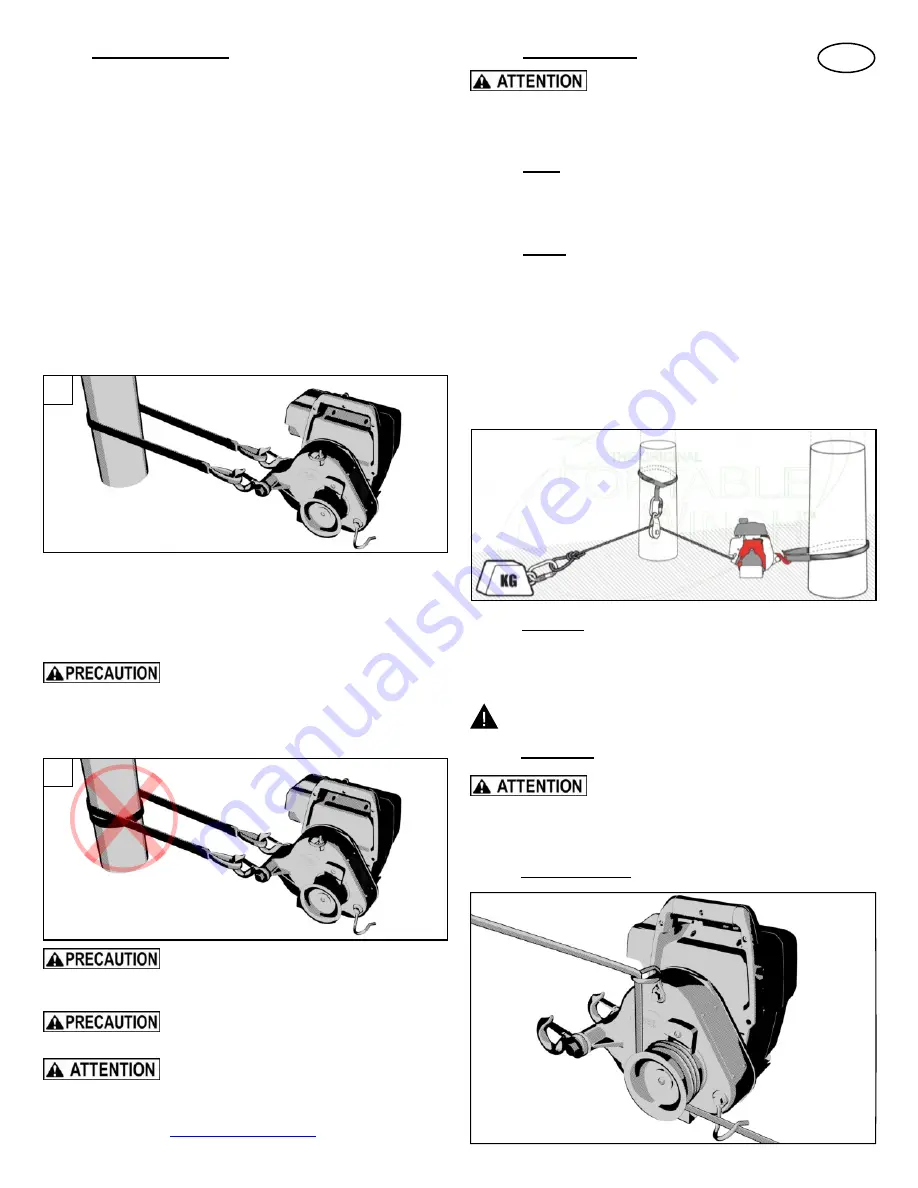
EN
6
3.5
Anchoring the winch.
OPTION 1:
In most cases, the winch is anchored to a fixed object using a
polyester sling or one of our optional anchors and the line is attached
to the object you are trying to move.
The latter is moved towards the winch as the winch pulls the line.
OPTION 2:
Sometimes, the winch can be anchored to the object you want to
move and the line is attached to a fixed object.
The winch and the object being moved are then pulled towards the
line's anchoring point. This method is useful when you guide the load
while operating the winch.
Your winch is supplied with a 2-meter polyester sling. To anchor the
winch, wind it around the anchoring point with the sling. Insert each
end of the sling in each of the two hooks located on the back of the
winch (fig. A).
Place the winch in the direction of the load to be pulled. When the
winch is switched on, it will attempt to align itself with the load. The
friction of the sling against the anchor may prevent correct alignment;
in this case, release the tension in the line and move the sling so that
the tension is distributed over the two books equally.
WHAT NOT TO DO:
WHEN YOU INSTALL THE SLING TO ANCHOR THE WINCH, AVOID A FULL TURN
AROUND AN ANCHORING POINT (FIG. 2 BELOW). THIS WILL PREVENT THE WINCH
FROM ALIGNING ITSELF WITH THE LOAD CORRECTLY.
THIS WILL ALSO APPLY UNEVEN TENSION TO EACH OF THE HOOKS.
AVOID INSTALLING THE SLING ON SHARP CORNERS LIKELY
TO DAMAGE THE POLYESTER SLING. WHEN YOU USE A
POLE, A TREE OR A STUMP AS AN ANCHORING POINT, INSTALL THE SLING CLOSE
TO THE BASE.
ANCHORING AROUND A STUMP REQUIRES SPECIAL
ATTENTION TO AVOID THE SLING SLIPPING OFF THE TOP
OF THE STUMP.
MAKE SURE THAT THE ANCHORING POINT IS ABLE TO
HANDLE THE PULLING WITHOUT BREAKING, BEING
UPROOTED OR BECOMING DAMAGED.
We also offer a wide range of anchoring accessories for our capstan
winches. Please see
www.portablewinch.com
3.6
Installing the line.
THE CORRECT DIRECTION WHEN DEPLOYING
THE LINE IS THE KEY TO SAFE USE OF THE WINCH.
The wide range of situations encountered during pulling prevents us
from given precise instructions; however, consider the following
points:
3.6.1
Rope.
Use a line with a low elasticity in good condition, with a minimum
diameter of 10 mm and a maximum diameter of 13 mm with good
knots. We highly recommend the bowline knot (§3.4).
3.6.2
Pulley.
Use pulleys to divert the line and increase the pulling power when the
load approaches or exceeds the winch's pulling capacity.
The use of a short-distance winch pulley offers the following benefits:
●
Provides an angle allowing the load to be slightly raised to
reduce friction;
●
Maintains the winch in an almost horizontal position;
●
Keeps the winch and the operator away from the load's
trajectory.
3.6.3
Direction.
Install the line so that it doesn't rub against any objects during pulling.
Try to install the line so that the front of the load is slightly raised.
Never pull downwards or through obstacles.
IN GENERAL, IF THE LINE TOUCHES THE GROUND DURING PULLING, THE
INSTALLATION IS INCORRECT.
3.6.4
On a slope.
NEVER PULL A LOAD ALONG A DESCENDING SLOPE
DIRECTLY TOWARDS THE WINCH BECAUSE THE LOAD MAY
SLIDE TOWARDS YOU WITHOUT YOU BEING ABLE TO STOP IT. IN THIS CASE, USE A
PULLEY AT THE BOTTOM OF THE SLOPE AND POSITION THE WINCH FURTHER BACK
AWAY FROM THE AXIS OF THE LOAD.
3.7
Tirer une charge.
A
B






















